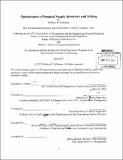Optimization of surgical supply inventory and kitting
Author(s)
Schlanser, Matthew R. (Matthew Ross)
DownloadFull printable version (10.63Mb)
Other Contributors
Leaders for Global Operations Program.
Advisor
Retsef Levi and David Simchi-Levi.
Terms of use
Metadata
Show full item recordAbstract
This project centered on inventory optimization for operative custom surgical packs and soft good supplies for Massachusetts General Hospital (MGH), a 947-bed medical center. Custom surgical packs are used in every surgical case and delivered to the hospital by a vendor who manufactures them off site. These large packs contain unwrapped surgical items (drapes, gown, sutures, etc.) delivered to each operating room prior to the start of surgery. Once a surgical pack is opened, the items inside are consumed or wasted. MGH uses the custom packs to reduce the amount of time warehouse associates spend picking individual items and to reduce preparation time in the operating rooms prior to the patient arriving. To augment the custom packs, individually packaged and sterilized items (called soft goods) are requested by the surgeon for each case. Specific case information, surgeon's preferences for materials, and patient needs dictate these soft good supply requirements. Soft goods are ordered from separate vendors and together with the custom packs comprise a surgeon's preference card. The hospital orders custom packs and soft goods with the intent to keep three days of supply on hand or to fill shelf space, whichever is greater. This situation triggers bloated and redundant inventory stores throughout MGH. Despite the sub-optimality of this policy, no analysis had informed hospital leadership of the correct levels of inventory or the best ways to cover preference cards. To solve these challenges, we formalized an optimization model that minimized the purchasing and holding costs of custom packs and soft goods while satisfying the supply requirements of all preference cards. As an input, the model used all current pack configurations and new pack configurations born from the overlaps of current surgical packs. Base stock reductions are achievable through covering "sibling" procedures with the new combined pack configurations and picking displaced items as soft goods. The model results revealed a modular pack structure as the most cost effective method to cover all preference cards. The new modular pack structure prescribed replacing 14 of the 65 current packs with 16 smaller packs to reduce overall value of inventory on hand. Currently, we estimate that this work will save the hospital in excess of $1.3M annually by reducing inventory on the shelf and lowering associated holding costs through risk pooling.
Description
Thesis (M.B.A.)--Massachusetts Institute of Technology, Sloan School of Management; and, (S.M.)--Massachusetts Institute of Technology, Engineering Systems Division; in conjunction with the Leaders for Global Operations Program at MIT, 2013. Cataloged from PDF version of thesis. Includes bibliographical references (p. 56).
Date issued
2013Department
Leaders for Global Operations Program at MIT; Massachusetts Institute of Technology. Engineering Systems Division; Sloan School of ManagementPublisher
Massachusetts Institute of Technology
Keywords
Sloan School of Management., Engineering Systems Division., Leaders for Global Operations Program.